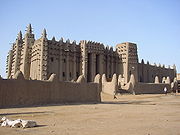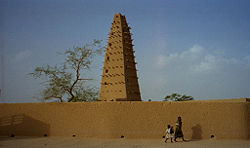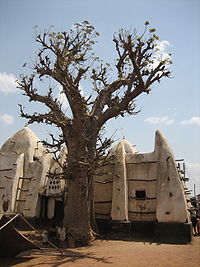
Sudano-Sahelian
Encyclopedia



Architectural style
Architectural styles classify architecture in terms of the use of form, techniques, materials, time period, region and other stylistic influences. It overlaps with, and emerges from the study of the evolution and history of architecture...
s common to the Islamized peoples of the Sahel
Sahel
The Sahel is the ecoclimatic and biogeographic zone of transition between the Sahara desert in the North and the Sudanian Savannas in the south.It stretches across the North African continent between the Atlantic Ocean and the Red Sea....
and Sudanian
Sudan (region)
The Sudan is the name given to a geographic region to the south of the Sahara, stretching from Western to Eastern Africa. The name derives from the Arabic bilâd as-sûdân or "land of the Blacks"...
(geographical) regions of West Africa
West Africa
West Africa or Western Africa is the westernmost region of the African continent. Geopolitically, the UN definition of Western Africa includes the following 16 countries and an area of approximately 5 million square km:-Flags of West Africa:...
, south of (and within) the Sahara
Sahara
The Sahara is the world's second largest desert, after Antarctica. At over , it covers most of Northern Africa, making it almost as large as Europe or the United States. The Sahara stretches from the Red Sea, including parts of the Mediterranean coasts, to the outskirts of the Atlantic Ocean...
, but above the savanna
Savanna
A savanna, or savannah, is a grassland ecosystem characterized by the trees being sufficiently small or widely spaced so that the canopy does not close. The open canopy allows sufficient light to reach the ground to support an unbroken herbaceous layer consisting primarily of C4 grasses.Some...
and fertile forest
Forest
A forest, also referred to as a wood or the woods, is an area with a high density of trees. As with cities, depending where you are in the world, what is considered a forest may vary significantly in size and have various classification according to how and what of the forest is composed...
regions of the coast. This style is characterized by the use of mudbrick
Mudbrick
A mudbrick is a firefree brick, made of a mixture of clay, mud, sand, and water mixed with a binding material such as rice husks or straw. They use a stiff mixture and let them dry in the sun for 25 days....
s and an adobe
Adobe
Adobe is a natural building material made from sand, clay, water, and some kind of fibrous or organic material , which the builders shape into bricks using frames and dry in the sun. Adobe buildings are similar to cob and mudbrick buildings. Adobe structures are extremely durable, and account for...
plaster, with large wooden-log support beams
Beam (structure)
A beam is a horizontal structural element that is capable of withstanding load primarily by resisting bending. The bending force induced into the material of the beam as a result of the external loads, own weight, span and external reactions to these loads is called a bending moment.- Overview...
that jut out from the wall face for large buildings such as mosques or palaces. These beams also act as scaffolding for reworking, which is done at regular intervals, and involves the local community. The earliest examples of Sudano-Sahelian style likely comes from Jenné-Jeno
Jenné-Jeno
Jenne-Jeno is the original site of Djenné, Mali and considered to be among the oldest urbanized centers in sub-Saharan Africa. It has been the subject of archeological excavations by Susan and Roderick McIntosh and has been dated to the 3rd century BC...
around 250 BC, where the first evidence of permanent mudbrick architecture in the region is attested.
Difference between Savannah and Sahelian styles
The earthen architecture in the Sahel zone region is noticeably different to the building style in the neighboring savannahSavannah
Savannah or savanna is a type of grassland.It can also mean:-People:* Savannah King, a Canadian freestyle swimmer* Savannah Outen, a singer who gained popularity on You Tube...
. The "old Sudanese" cultivators of the savannah built their compounds out of several cone-roofed houses. Here on the other hand cubic buildings with terraced roofs comprise the typical style. They lend a characteristic appearance to the close-built villages and cities. Large buildings such as mosques, representative residential and youth houses stand out in the distance. They are landmarks in a flat landscape that point to a complex society of farmers, craftsmen and merchants with a religious and political upper class.
Three Main Types
The Sudano-Sahelian architectural style itself can be broken down in to three smaller sub-styles that are typical of different ethnic groups in the region. The examples used here illustrate the construction of mosques, as the architectural style is concentrated around inland MuslimMuslim
A Muslim, also spelled Moslem, is an adherent of Islam, a monotheistic, Abrahamic religion based on the Quran, which Muslims consider the verbatim word of God as revealed to prophet Muhammad. "Muslim" is the Arabic term for "submitter" .Muslims believe that God is one and incomparable...
populations. These include:
- Malian - of the various Manden groups of southern and central Mali. Characterized by the Great Mosque of Djenne and the Kani-Kombole Mosque of Mali.
- Hausa-Fulani or Fortress - of the HausaHausa peopleThe Hausa are one of the largest ethnic groups in West Africa. They are a Sahelian people chiefly located in northern Nigeria and southeastern Niger, but having significant numbers living in regions of Cameroon, Ghana, Cote d'Ivoire, Chad and Sudan...
, Fulani and Zarma peoples of northern NigeriaNigeriaNigeria , officially the Federal Republic of Nigeria, is a federal constitutional republic comprising 36 states and its Federal Capital Territory, Abuja. The country is located in West Africa and shares land borders with the Republic of Benin in the west, Chad and Cameroon in the east, and Niger in...
and western NigerNigerNiger , officially named the Republic of Niger, is a landlocked country in Western Africa, named after the Niger River. It borders Nigeria and Benin to the south, Burkina Faso and Mali to the west, Algeria and Libya to the north and Chad to the east...
, and Songhai of northeastern MaliMaliMali , officially the Republic of Mali , is a landlocked country in Western Africa. Mali borders Algeria on the north, Niger on the east, Burkina Faso and the Côte d'Ivoire on the south, Guinea on the south-west, and Senegal and Mauritania on the west. Its size is just over 1,240,000 km² with...
. Military aspect in construction of high protective compound walls built around a central courtyard. Minaret is the only building with support beams showing. Characterized by the Sankore Mosque of TimbuktuTimbuktuTimbuktu , formerly also spelled Timbuctoo, is a town in the West African nation of Mali situated north of the River Niger on the southern edge of the Sahara Desert. The town is the capital of the Timbuktu Region, one of the eight administrative regions of Mali...
, the tomb of Askia in GaoGaoGao is a town in eastern Mali on the River Niger lying ESE of Timbuktu. Situated on the left bank of the river at the junction with the Tilemsi valley, it is the capital of the Gao Region and had a population of 86,663 in 2009....
Mali, and the AgadezAgadez-Sources:* Aboubacar Adamou. "Agadez et sa région. Contribution à l'étude du Sahel et du Sahara nigériens", Études nigériennes, n°44, , 358 p.* Julien Brachet. Migrations transsahariennes. Vers un désert cosmopolite et morcelé . Paris: Le Croquant, , 324 p. ISBN : 978-2-91496865-2.*. Saudi Aaramco...
mosque of northern Niger.
- Volta basin - of the GurGur-People:*Mordechai Gur , Israeli politician and the 10th Chief of Staff of the Israeli Defense Forces-Places:*A village in Tibet, see Gur, Tibet*Gur place name in ancient Israel near Megiddo*Guernsey, one of the Channel Islands-Other:...
and Manden groups of Burkina FasoBurkina FasoBurkina Faso – also known by its short-form name Burkina – is a landlocked country in west Africa. It is surrounded by six countries: Mali to the north, Niger to the east, Benin to the southeast, Togo and Ghana to the south, and Côte d'Ivoire to the southwest.Its size is with an estimated...
and northern GhanaGhanaGhana , officially the Republic of Ghana, is a country located in West Africa. It is bordered by Côte d'Ivoire to the west, Burkina Faso to the north, Togo to the east, and the Gulf of Guinea to the south...
. The most conservative of the three styles. A single courtyard, characterised by high white and black painted walls, inward curved turrets supporting an exterior wall, and a larger turret nearer the center. Characterized by the LarabangaLarabangaLarabanga is a town in north western Ghana. It is known for its mud-built whitewashed Sahelian mosque, said to date from 1421. It was at the height of the trans-Saharan trade...
mosque of GhanaGhanaGhana , officially the Republic of Ghana, is a country located in West Africa. It is bordered by Côte d'Ivoire to the west, Burkina Faso to the north, Togo to the east, and the Gulf of Guinea to the south...
and the Bobo-DioulassoBobo-DioulassoBobo-Dioulasso is a city with a population of about 435,543 , the second largest city in Burkina Faso, Africa, after Ouagadougou, the nation's capital. The name means literally, "home of the Jula who speak Bobo," and is possibly a creation of the French who misunderstood the identity complexities...
Grand Mosque.
The highlights of Sudano-Sahelian mosque architecture are without doubt to be found in the mid-Niger region between Ségou
Ségou
Ségou is a city in south-central Mali, lying northeast of Bamako on the River Niger, in the region of Ségou. It was founded by the Bozo people, on a site about from the present town...
and Gao
Gao
Gao is a town in eastern Mali on the River Niger lying ESE of Timbuktu. Situated on the left bank of the river at the junction with the Tilemsi valley, it is the capital of the Gao Region and had a population of 86,663 in 2009....
with the inner delta as the center. They outdo all other west Sudanese regions in terms of the number and quality of sacred buildings. They have been extensively inventorised by Archnet
ArchNet
ArchNet is the world’s largest online databank of international architecture. It was developed at the University of Texas at Austin and the MIT School of Architecture and Planning in co-operation with the Aga Khan Trust for Culture...
.
See also
- Islam in AfricaIslam in AfricaFrom its beginning, Islam has been a central feature in Africa. Africa was the first continent into which Islam expanded, and it has become an integral part of many African cultures and histories. According to World Book Encyclopedia, Islam is the largest religion in Africa, followed by Christianity...
- Sankore UniversitySankore UniversitySankoré Madrasah, The University of Sankoré, or Sankore Masjid is one of three ancient centers of learning located in Timbuktu, Mali, West Africa. The three mosques of Sankoré, Djinguereber Mosque and Sidi Yahya compose the famous University of Timbuktu...
- LarabangaLarabangaLarabanga is a town in north western Ghana. It is known for its mud-built whitewashed Sahelian mosque, said to date from 1421. It was at the height of the trans-Saharan trade...
- AgadezAgadez-Sources:* Aboubacar Adamou. "Agadez et sa région. Contribution à l'étude du Sahel et du Sahara nigériens", Études nigériennes, n°44, , 358 p.* Julien Brachet. Migrations transsahariennes. Vers un désert cosmopolite et morcelé . Paris: Le Croquant, , 324 p. ISBN : 978-2-91496865-2.*. Saudi Aaramco...
- Great Mosque of DjennéGreat Mosque of DjennéThe Great Mosque of Djenné is the largest mud brick or adobe building in the world and is considered by many architects to be the greatest achievement of the Sudano-Sahelian architectural style, with definite Islamic influences. The mosque is located in the city of Djenné, Mali on the flood plain...

